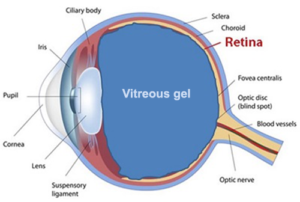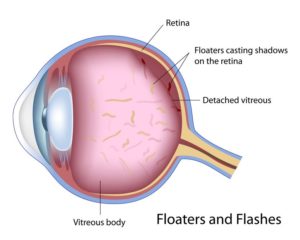Posterior Vitreous Detachment
A common eye condition as we age
Posterior vitreous detachment (PVD) is a very common eye condition. It’s caused by natural changes to the vitreous gel that takes up the space inside the eye. Many people develop posterior vitreous detachments and never experience symptoms, whereas others may notice floaters and flashes.
Although PVD causes some frustrating symptoms, it doesn’t cause pain, harm the eye or cause permanent loss of vision.
Understanding PVD
 Basically, the eye is divided into three sections: the anterior chamber, the vitreous chamber and the posterior chamber. The vitreous chamber is positioned at the back of the eyeball between the lens and the retina. It is the largest of the chambers and takes up around 80% of the eye. It contains a clear, colourless, jelly-like fluid.
Basically, the eye is divided into three sections: the anterior chamber, the vitreous chamber and the posterior chamber. The vitreous chamber is positioned at the back of the eyeball between the lens and the retina. It is the largest of the chambers and takes up around 80% of the eye. It contains a clear, colourless, jelly-like fluid.
The vitreous protects your eye, and most importantly, helps the eye to hold its ‘spherical’ shape and keeps the retina in place.
Causes
 As you get older the vitreous in your eye becomes more watery, less gel-like and isn’t able to keep its usual shape. This causes it to move away from the retina at the back of the eye towards the centre of the eye. This is known as posterior vitreous detachment (PVD).
As you get older the vitreous in your eye becomes more watery, less gel-like and isn’t able to keep its usual shape. This causes it to move away from the retina at the back of the eye towards the centre of the eye. This is known as posterior vitreous detachment (PVD).
Because these changes to the vitreous are natural, over 75 per cent of people over 65 develop PVD. It’s not a sign of disease or eye health problem and any symptoms usually get better with time.
Diagnosis
The early symptoms of PVD are very similar to the symptoms of a retinal detachment. It’s really important for you to get a professional diagnosis to confirm that the symptoms aren’t related to a more serious condition.
If you experience any of the symptoms below, you should arrange to have your eyes examined by one of our Auckland optometrists within 24 hours.
- a sudden experience of floaters or an increase in their size and number
- flashes of light and/or a change/increase in the flashing lights you experience
- blurring vision
- a dark curtain moving up, down or across your vision
What are floaters and flashes?
If you’ve had PVD, you may be aware of floaters and little flashes of light in your vision.
- Floaters: As the vitreous becomes more watery, small, harmless clumps of cells develop and “float about” in your vision. These can cast a shadow onto the retina. Floaters can be in different shapes and sizes from small dots to larger cloud shaped spots or long strands. Some people can have lots of small floaters in their vision, while others may have just one or two larger ones. Floaters might move around quickly or hardly move at all. Some larger floaters may be more noticeable and distracting because they get in the way when you’re looking at something. They generally move as the eyes move, and are most noticeable against a plain bright background, such as a white or light-coloured wall. This can be frustrating and make tasks such as reading more difficult.
- Flashes: These small flashes of light are comparable to “seeing stars” after hitting your head. They can last a few seconds or minutes. As the vitreous detaches, it can pull on the retina. The retina reacts by sending a small electrical charge to your brain that you see as short, small flashes of light, which you’ll often see more in the dark or dim lighting. When the vitreous gel becomes fully detached this symptom should settle down – although many people experience some flashes from time to time.
- Cobweb effect: You may begin to see the outer edge of the vitreous as it separates from the retina. This can change the way light passes through the eye and it can feel like you’re looking through a cobweb. This effect disappears when the vitreous comes away from the retina.
Treatments
PVD on its own does not cause any permanent loss of vision. Once your PVD has been diagnosed, you’ll find that the symptoms can be frustrating in the short-term, but they usually settle down over time.
How does PVD change with time?
You may find that your symptoms only last a few weeks, but it’s more common for them to last about six months. The floaters and flashes of light which come with PVD will gradually calm down over time as your brain learns to ignore your them; you should see just as well as you did before your PVD began.
You may still be aware of your floaters even after the flashes of light have stopped. which can be very frustrating, but if your symptoms do take longer to improve, it doesn’t mean that there’s anything wrong.
However, if you’re worried, you should get advice from the optometrist you saw at our Auckland practice when you first came in for your eye examination.
Your brain will gradually learn to ignore the floaters but in the meantime:
Some useful tips that might help you cope with floaters:
- If you have a particularly large floater, try moving your eyes gently around in circles. This moves the vitreous inside your eyes and can sometimes move the floater away from your direct field of vision, making you less aware of it.
- Wear any glasses you need. When your vision is clearer, you’re more likely to be able to concentrate on what you’re doing, rather than on the floaters.
- Wear sunglasses in bright conditions or reduce the brightness on your computer screen. When light comes into your eye, you notice your floaters because they cast shadows on the retina at the back of your eye. Tinted lenses reduce the amount of light entering your eyes, so the floaters cast a fainter shadow on your retina and are less noticeable.
Between our Henderson Optometry practice and our optometrists in Newmarket our staff has dedicated over 35 years’ helping Aucklanders through many a see change. If you’re at all worried about changes in your vision, call 09 522 1283 or 09 836 1731 to schedule a comprehensive eye test.

